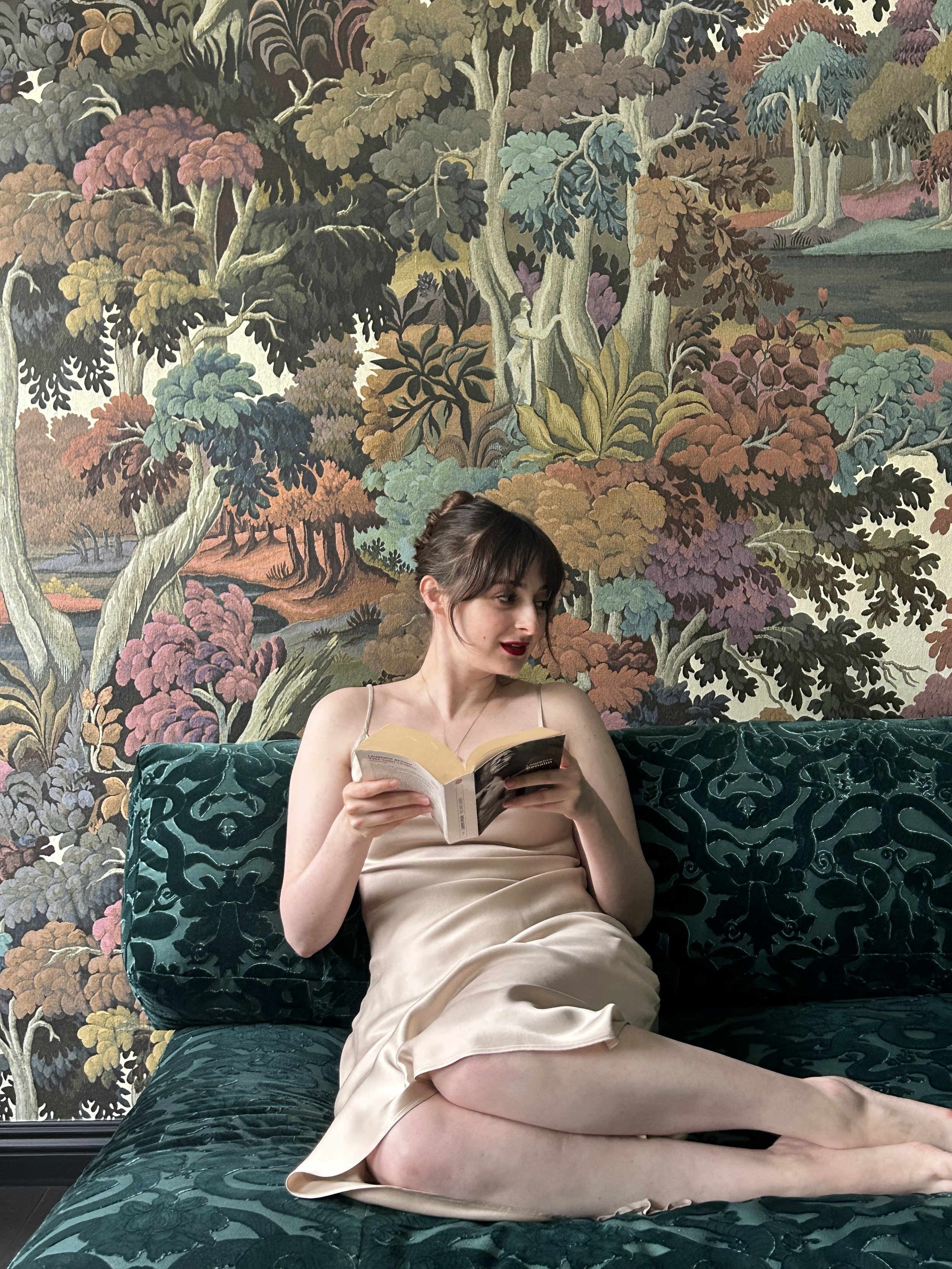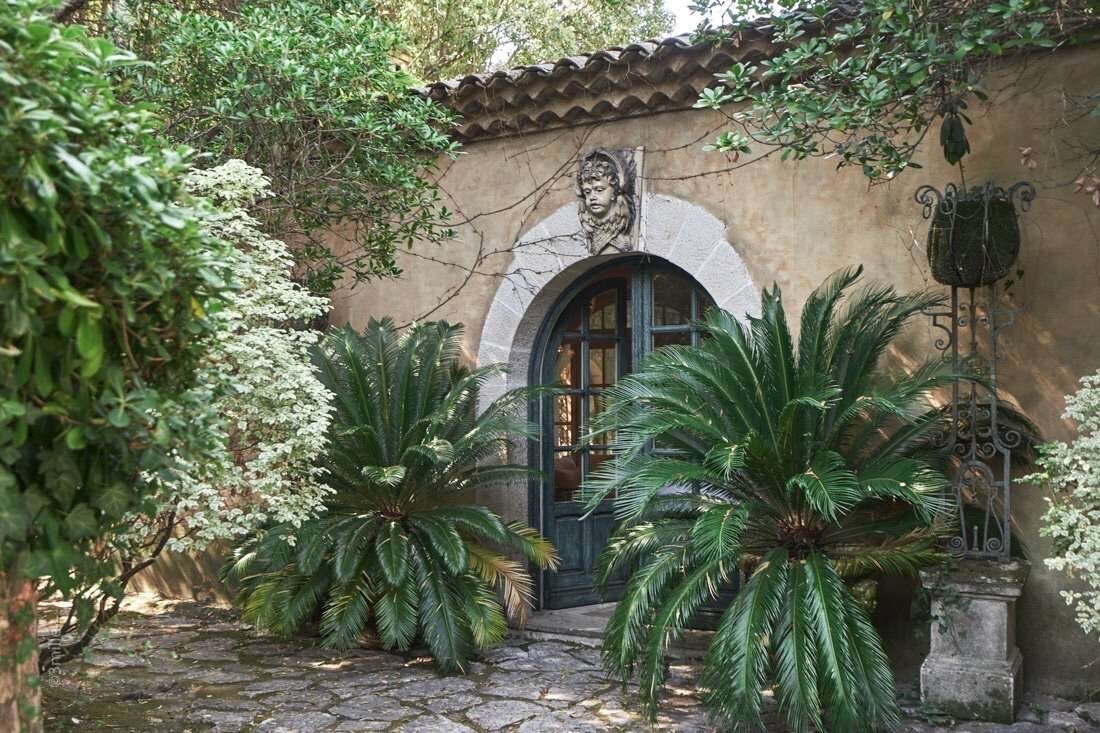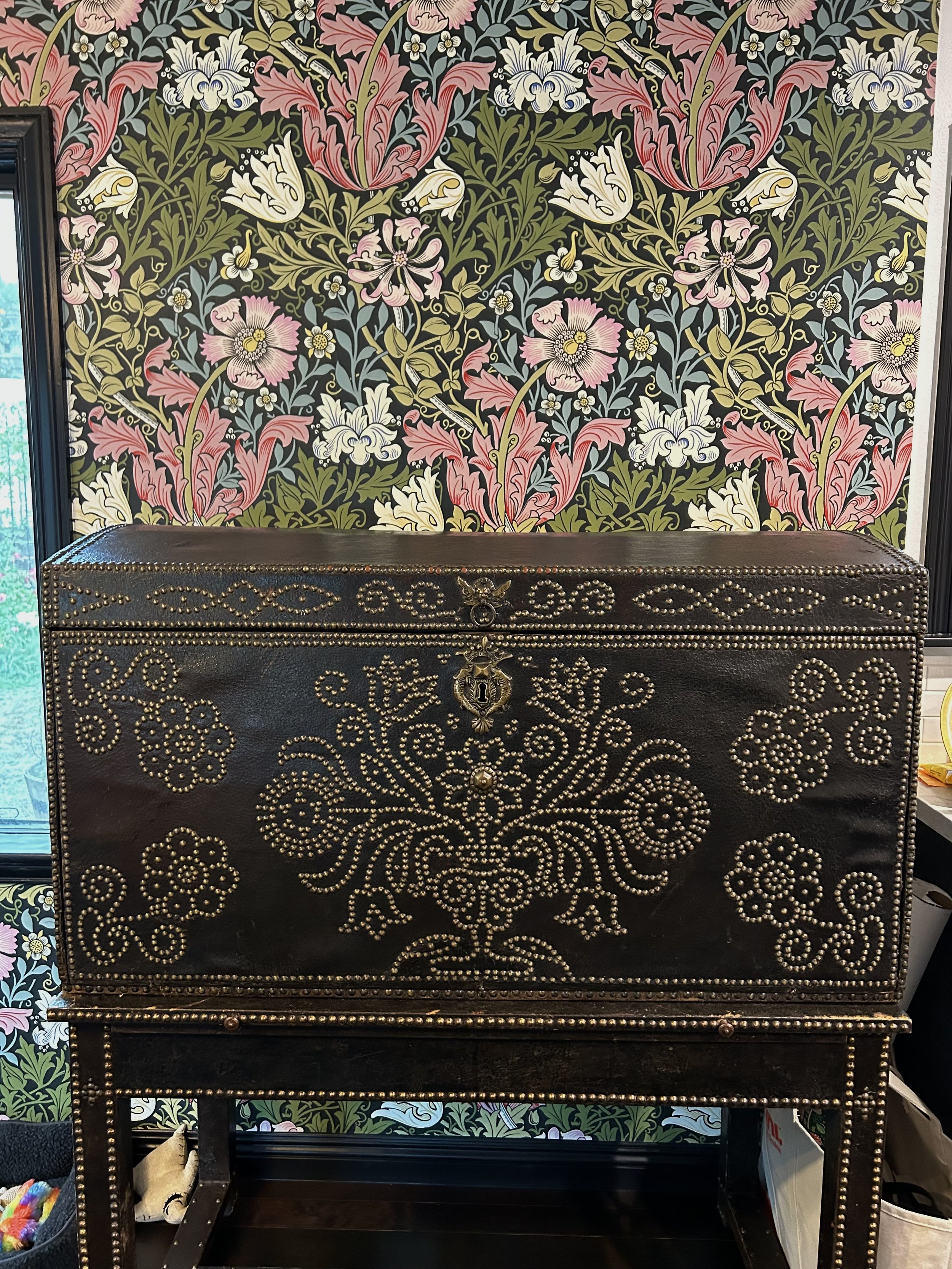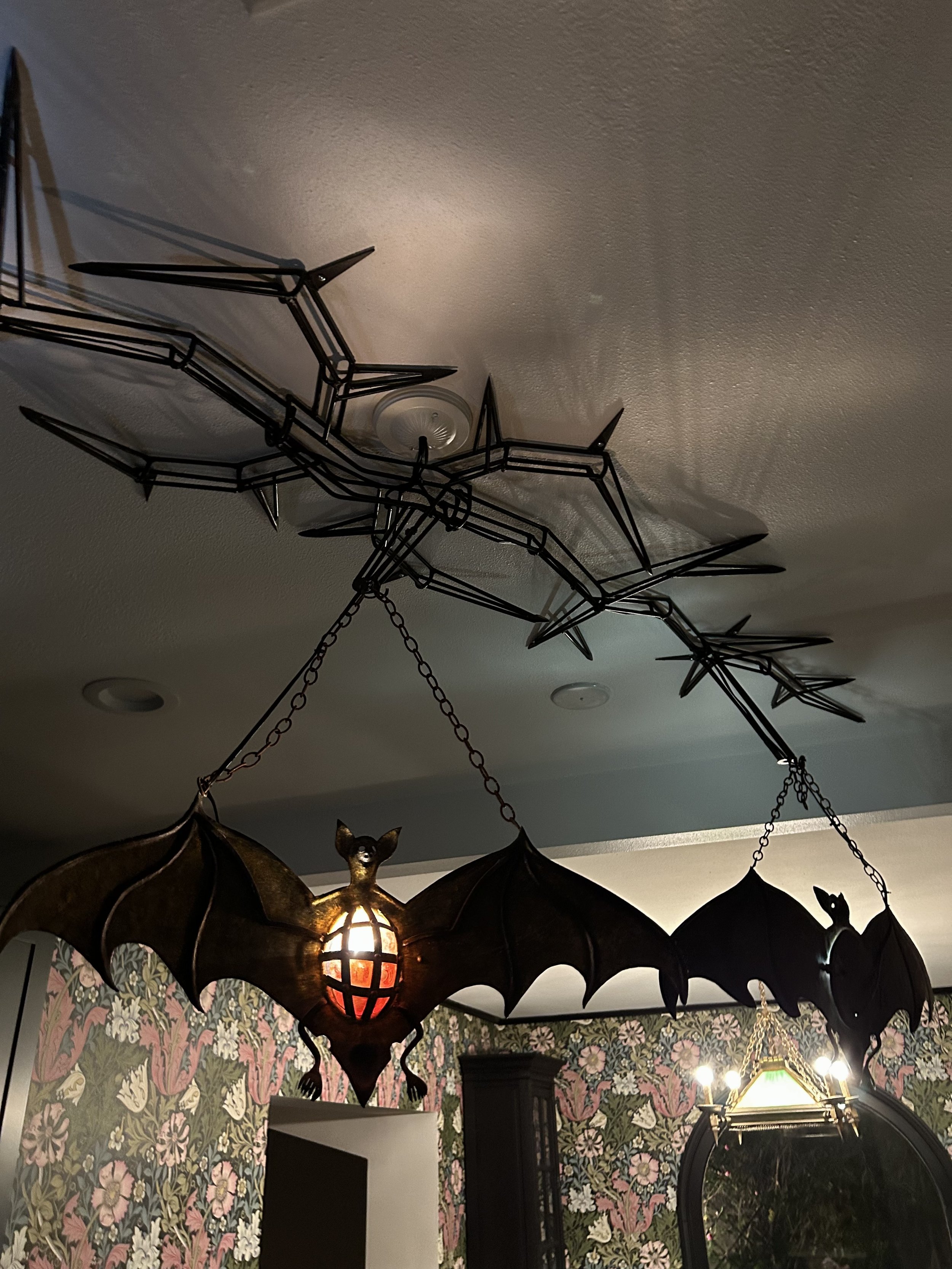†
COLLECTORS
The Googly-Eyed Girl
A Q&A with Chloë Helen America Cassens
Edited by Margot Mayer
11 June 2023
In 2018, a terrible storm ravaged the Musée Jean Cocteau, flooding the basement with sea water and damaging much of the collection of Severin Wunderman: the Gucci watchmaker and world’s most prolific collector of works by Cocteau, who passed away in 2008. Since the storm, the museum has remained closed. Today Chloë Cassens, Severin’s granddaughter, continues on his legacy as the official representative of the collection. Her moda operandi is to usher in a renaissance for both Cocteau and Wunderman, both stateside and around the globe. Below, she reflects on the influence of her grandfather on her relationship to antiques, considers the nature of collecting, and shares some of her favorite pieces from her personal collection.
Photo by Elle Quintana
Chloë Cassens: I have the incredible privilege of being the granddaughter of Severin Wunderman, a Belgian Holocaust survivor who became a fantastically successful watchmaker. Severin used his fortune to amass the world’s largest collection of works by Jean Cocteau, but his passion for art and antiques extended far past Cocteau into his contemporaries: Sarah Bernhardt (he had a significant collection of memorabilia and art relating to her, as well), and beyond. Although my grandfather was married seven times – to six women – the Severin Wunderman Collection, which I have the honor of representing today, was the true love of his life.
I grew up in my grandfather’s home, Château Montfort in La-colle-sur-loup. The chateau was a refurbished 16th century hunting lodge that once belonged to King François I of France. I often wonder if it was real or if I imagined it! There was an original mural wrapping around a spiral stone staircase, a dungeon, a little room at the top of a turret, the whole nine yards. It was something out of a fairytale!
Courtesy of Chloë Cassens
Courtesy of Chloë Cassens
Courtesy of Chloë Cassens
“Although my grandfather was married seven times – to six women – the Severin Wunderman Collection, which I have the honor of representing today, was the true love of his life.”
There were very few modern pieces I can remember growing up with. After my grandfather passed away in 2008 – we were very close – I started on the path I’m still on, trying to understand him and his follies. I devoted my academic life to the study of Cocteau to try and parse why Severin was so obsessed with him. I also developed my own interests in art and history, and ironically discovered that he had collected some pieces that related to those, as well. (For example: I find Louis XIV and his mistress, the Marquise de Montespan, to be a fascinating couple, and learned that Severin kept portraits of the Marquise and her rival in one of his home offices).
When he was alive, he would tell me that a piece of art wasn’t worth buying if you didn’t want to look at it every single day, no matter if it was a Picasso or a caricature bought on a boardwalk. He said that every time he was persuaded by some shifty “expert” into purchasing something he didn’t like on the basis of it being an “investment,” he lost money on its inevitable resale.
While I in no way have a collection that can compare to his, I certainly inherited his passion, which is more than enough for me!
Courtesy of Chloë Cassens
Courtesy of Chloë Cassens
Courtesy of Chloë Cassens
How did you begin collecting antiques? Are there any particular eras or pieces you gravitate towards?
My journey into antiques wasn’t necessarily born of an interest in them – I would say the majority of the antiques I own were either given to me before I could understand what they were, or were things myself and my family purchased from my grandfather’s estate. (After he passed, he mandated that all his belongings be sold with the proceeds benefiting charity.) Only later, once I could appreciate history and what owning antiques can truly mean, did my passion for them ignite.
Nowadays, I really gravitate towards Art Nouveau pieces. My mother is an immigrant from Belgium, and Art Nouveau — along with many other important, influential artists and design movements! — originated there. Besides being drawn to the sensuousness and beauty of the movement, I also feel a connection to it as a part of Belgian culture.
What is the first piece you got for yourself? What do you remember about that experience?
When I think of “first pieces,” I think of a few things. My first piece of art was a Provençal scene painted by my “uncle” Lennie Barin. I saw it at a gallery show he had in the south of France one summer as a kid. I must have been 10 years old, and traded him a pair of earrings for it (my ears are not pierced and I thought I got the better deal at the time).
Courtesy of Chloë Cassens
My first real antique was a 1940s Coromandel lacquer screen I bought when I moved into my first apartment, which was a sixth-floor walk-up in New York’s West Village. It was the only thing in that apartment that didn’t come from IKEA or CB2. I used it as a headboard until I moved back to Los Angeles, where I used it to divide what was then my very open living space. Nowadays, it lives in my home office as a piece of art. It wasn’t too expensive for what it was, but I spent almost double what it originally cost to have it shipped to LA from NYC when I moved.
What kind of collector are you? What is your relationship to the act of collecting and the items you collect?
I would describe myself as an obsessive collector: I will fixate on something, needing to know every possible detail there is to know, and only have eyes for that particular era for months or years at a time. At present, I would say I collect three things: antiques, clothing, and plants. Right now, I am especially proud of my garden. I designed it and selected each plant for it myself. I also do the majority of its maintenance on my own, with some help on the “heavy lifting” from an incredible gardener every few months. My #GothGarden, as I call it, currently plays home to almost 50 exotic and unusual roses; helleborus; camellia trees; a blood orange tree; Meyer lemons; ‘Midnight Marvel’ hibiscus; sage, marjoram, oregano, thyme, mint and rosemary, which I cook with; and jasmine, which creates a fragrant wall between myself and the street.
“… I sincerely believe that if you’re meant to have something, then it will be yours in your lifetime. That object may come back around to you, or perhaps its absence is leaving room for something else to fill.”
Chloë’s Collection
Louis XIV Chest
I have the high honor of housing this incredible Louis XIV-era campaign chest & desk that belongs to my mother. (It’s too precious to live in a storage unit, but is quite bulky. I have the physical space for it, so for now it gets to live with me.) Back in those times – 350 years ago – royalty and other aristocrats (the people who had more than one residence) owned one set of everything, which would move with them when they’d move between palaces and châteaux. To the untrained eye, this is a gorgeous studded leather trunk with a matching stand; but in reality, it’s actually a travel chest which opens to become a writing desk. It is spectacular!
Courtesy of Chloë Cassens
Courtesy of Chloë Cassens
Courtesy of Chloë Cassens
Courtesy of Chloë Cassens
Art Nouveau Banker’s Lamp
I first saw this banker’s lamp when Margot released it on Curio Shop, and immediately fell in love with its lion-paw feet. I wasn’t ready to commit and was worried that it would sell instantly. Luckily, before it could sell, I was fortunate enough to receive it as a birthday gift from my amazing aunt, Deborah Drucker, who hosts a podcast called Deborahcratic.
(also pictured below is the previously mentioned Coromandel screen.)
Photo by Elle Quintana
Photo by Elle Quintana
Art Nouveau Bat Lights
When I was very little, my grandfather had a fully renovated antique Roma caravan on his property. It was filled with tons of antique curios, including three Art Nouveau era, electric iron bat lanterns. A very long story short, in 2019 we found the bats in a box buried deep in a storage unit. I named them Byron, Shelley and Polidori, and bats have become something of a personal symbol for me. A talented craftsman made a “thorn bush” to hang them from, and now they watch over my kitchen. Some people think they’re Halloween decorations I haven’t taken down yet. Little do they know…
Courtesy of Chloë Cassens
Courtesy of Chloë Cassens
Empress Josephine Rose
Some people spend hundreds of thousands—even millions—of dollars for Napoleon I’s memorabilia, but little do they know that they can find a piece of Bonaparte history for less than $50. The Empress Josephine rose is an Old Rose. (Note: Roses come in 5 classes, and Old Roses are ones that existed before more modern cultivating and hybridization practices became popular in the 19th century. To be classified as an Old Rose, it has to be of a type that existed before 1867.) This particular rose is believed to have been bred by the empress herself (her original name was Rose, before Napoleon rechristened her Josephine). She was famously an avid rosarian, and had the largest collection of rose varieties at the time at her home at Malmaison – including this one, which survives today!
Photo by Elle Quintana
Photo by Elle Quintana
Marcelle Leoni, Kees Van Dongen
When I was thirteen years old, I got an Edie Sedgwick haircut. As it grew out, I started styling it in a “China doll” style bob with bangs that my grandfather went wild for – he loved the cut and insisted I keep it. Shortly after he passed away, I realized why he was so taken with my appearance: I almost exactly resembled this piece by Fauvist artist Kees Van Dongen, which hung in Severin’s private office. This one was a gift from Van Dongen to Cocteau, inscribed “à Cocteau – amicablement – Van Dongen.” Her name is Marcelle Leoni but I have always called her “The Googly-Eyed Girl.”
Courtesy of Chloë Cassens
Courtesy of Chloë Cassens
Curio Questionnaire
Dream curio to collect?
I have been really fascinated by Renaissance and 17th-century pomanders lately. Back in that era, the upper-classes would wear heavily jeweled ones on thick gold chains around their waists, often with tiny books of hours, keys, and more attached to them.
German Pomander, 16th century, Gilt Silver. In the Collection of the Metropolitan Museum of Art.
Detail from "Portrait of an Unknown French Noblewoman," 1560, Hallwyl Palace.
Italian Pomander, 17th Century, Silver. In the Collection of the Metropolitan Museum of Art.
Most unexpected place you found something, or the extreme lengths you went to take it home?
I have driven several hours and vastly out of my way to pick up exotic roses for my garden! Last year, I bought a mature climber to create a wall between myself and my neighbor. It was so tall I had to load it into the trunk of my Mini Cooper laying down like a Christmas tree, and even still I had to drive the hour and half home with it hanging out of the front passenger window.
One that got away? Share a piece that you didn't take home but will always remember.
As often as I’ve come across things that I probably should have purchased, I sincerely believe that if you’re meant to have something, then it will be yours in your lifetime. That object may come back around to you, or perhaps its absence is leaving room for something else to fill.
Dream dinner party! Guests and menu preview?
Food-wise, my dream would involve me not having celiac disease, and I would be able to go to town on a perfect loaf of crusty French bread with salted butter while wearing something suitably fabulous by my friend Paul Burgo of Factory New York. My miniature dachshund, Louis, would be on his best behavior. Guests would be Josephine Bonaparte, David Bowie, Elizabeth Taylor, my beloved grandfather, Sarah Bernhardt, and Oscar Wilde. After dinner, Grace Jones performs for us!
Favorite interiors in three words?
Lively, lush, sensual.
Least favorite interiors in three words?
Impersonal, minimal, joyless.
Courtesy of Chloë Cassens
Chloë Helen America Cassens is 29 years old & lives in Los Angeles with her mini- dachshund, Louis. She is the official representative of the Severin Wunderman Collection, which makes up the contents of the Musée Jean Cocteau in Menton, France.
Follow her on Instagram @helen.america to stay up to date on all her latest adventures & work.
This interview has been lightly edited for length and clarity.
























